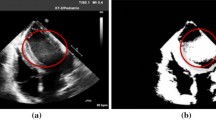Abstract
The real-time myocardial contrast echocardiography (RT MCE) is a new echocardiography technology, which allows clinicians to noninvasively evaluate the perfusion of myocardial capillary of patients, using the quantitative analysis of RT MCE. But the accurate analysis requires tracking the position of region of interest (ROI) within the myocardial area, so as to compensate for the translation or rotation offsets, which are due to such uncontrollable factors as heart motion. We used diamond search method and Brox’s coarse-to-fine warping optical flow technique for this ROI tracking problem. We validated our methods by comparing the quantitative analysis results of RT MCE using our methods with those using Lucas & Kanade’s optical flow technique, which had been report to be accurate enough for this ROI tracking. We finally present some examples of animal experiment to show the effectiveness and the clinical application value of our ROI tracking methods.


Similar content being viewed by others
References
Sanjiv, K., Myocardial contrast echocardiography: A 25-year retrospective. Circulation. 118:291–308, 2008.
Jayaweera, A. R., Matthew, T. L., Sklenar, J., et al., Method for the quantification of myocardial perfusion during myocardial contrast twodimensional echocardiography. J. Am. Soc. Echocardiogr. 3:91–98, 1994.
Wei, K., Jayaweera, A. R., Firoozan, S., Linka, A., Skyba, D. M., and Kaul, S., Quantification of myocardial blood flow with ultrasound-induced destruction of microbubbles administered as a constant venous infusion. Circulation. 97:473–483, 1998.
Wei, K., Ragosta, M., Thorpe, J., Coggins, M., Moos, S., and Kaul, S., Noninvasive quantification of coronary blood flow reserve in humans using myocardial contrast echocardiography. Circulation. 103:2560–2565, 2001.
http://www.gehealthcare.com/usen/ultrasound/products/vivid7_dim.html.
http://www.medical.philips.com/main/products/ultrasound/technologies/qlab/qlab_main.wpd.
Noble, J. A., Dawson, D., Lindner, J., Sklenar, J., and Kaul, S., Automated nonrigid alignment of clinical myocardial contrast echocardiography image sequences: Comparison with manual alignment. Ultrasound in Med. and Biol. 28:115–123, 2002.
Malpica, N., Santos, A., Zuluaga, M. A., et al., Tracking of regions-of-interest in myocardial contrast echocardiography. Ultrasound in Med. and Biol. 30:303–309, 2004.
Gao, H.-x., Statistics Computation. Peking University Press, 1995.
Lucas, B., and Kanade, T., An iterative image registration technique with an application to stereo vision. In: Proceedings DARPA IU Workshop. 21–130, 1981.
Brox, T., Bruhn, A., Papenberg, N., et al., High accuracy optical flow estimation based on a theory for warping. Lecture Notes in Computer Science. 3024:25–36, 2004.
Zhu, S., and Ma, K. K., A new diamond search algorithm for fast block-matching motion estimation. IEEE Trans. Image Processing. 9:287–290, 2000.
Zhang, M.-q., Sun, F.-r., and Yao, G., Development of a new MCE-based quantitative analysis system for myocardial microcirculation. J. Biomed. Eng. 25(3):708–711, 2008.
Yao, G.-h., Zhang, C., Sun, F.-r., Zhang, M., Zhao, Y.-x., Zhang, P.-f., Zhong, L., Ding, S.-f., Chen, W.-q., Li, X.-n., and Zhang, Y., Quantification of transmural gradient of blood flow in myocardial ischemia with real-time myocardial contrast echocardiography and dipyridamole stress test. Ultrasound in Medicine and Biology. 34(1):22–30, 2008.
So, H., Kim, J., Cho, W. K., and Kim, Y. S., Fast motion estimation using modified diamond search patterns. Electronics Letters. 41(2):62–63, 2005.
Press, W., Teukolsky, S., Vetterling, W., and Flannery, B., Numerical recipes: the art of scientific computing, 3rd edition. Cambridge University Press, Cambridge, 2007.
Acknowledgments
This work is supported by the Outstanding Young Scientist Foundation of Shandong Province under the grant 2005BS01006.
Author information
Authors and Affiliations
Corresponding author
Rights and permissions
About this article
Cite this article
Sun, Fr., Zhang, Mq., Jia, Xb. et al. Region of Interest Tracking in Real-Time Myocardial Contrast Echocardiography. J Med Syst 35, 163–167 (2011). https://doi.org/10.1007/s10916-009-9353-y
Received:
Accepted:
Published:
Issue Date:
DOI: https://doi.org/10.1007/s10916-009-9353-y




